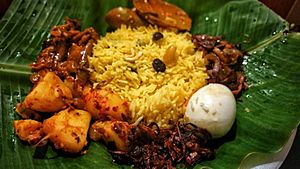Lamprais facts for kids

A serving of lamprais
|
|
| Type | Main Meal |
|---|---|
| Course | Main Meal |
| Place of origin | Sri Lanka |
| Main ingredients | mixed meat curry, ghee rice, ash plantain, frikkadeller meatballs, belacan, seeni sambol, eggplant pahi |
Lamprais is a super yummy and unique meal from Sri Lanka. It's often spelled "Lumprice" or "Lumprais" too. This special dish was brought to Sri Lanka by a group of people called the Dutch Burghers.
The name "Lamprais" comes from the Dutch word lomprijst. This word basically means "a packet of rice" or "a lump of rice." Many people also think this tasty meal might have come from an Indonesian dish called Lemper.
A Taste of History: Where Did Lamprais Come From?
From 1658 to 1796, the coast of Sri Lanka was ruled by the Dutch. During this time, the Dutch Burghers created Lamprais. These Burghers are an ethnic group with mixed Dutch, Portuguese Burghers, and Sri Lankan roots.
Interestingly, Lamprais is not a traditional Dutch meal. It's actually based on a Javanese dish called Lemper. Lemper is a snack made with seasoned shredded meat and glutinous rice. It's all wrapped up in a banana leaf.
The Dutch in Dutch Ceylon (which is what Sri Lanka was called then) probably learned about this dish. They adapted it from the Dutch East Indies in the early 16th century. One of the first times Lamprais was written about was in a cookbook. It was in Hilda Deutrom's Ceylon Daily News Cookery Book, published in 1929.
What's Inside a Lamprais?
Lamprais is a complete meal wrapped up in a banana leaf. It's then baked in an oven. This makes all the flavors mix together perfectly!
Here's what you'll usually find inside:
- Two special curries:
* A three-meat curry, often with beef, pork, and chicken. * A curry made with ash plantain and aubergine.
- Seeni sambol, which is a sweet and spicy onion relish.
- Belacan, a flavorful shrimp paste.
- Frikadeller meatballs, which are small, tasty meat patties.
- Rice that has been cooked in a rich meat stock.
The rice itself is special. Raw short-grain rice is first fried with onions and spices in butter or ghee. Then, it's cooked in a delicious meat stock. Sometimes, a deep-fried hard-boiled egg is added too. This is a common addition, even if it's not part of the oldest recipes.
Traditionally, Lamprais always had three kinds of meat. But today, you can find many different versions. Some have just one type of meat, like fish or chicken. There are even vegetarian versions available!


